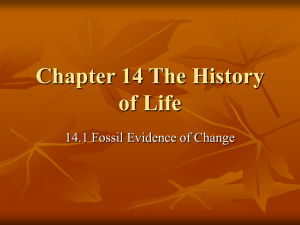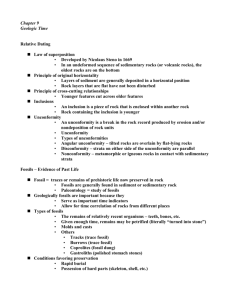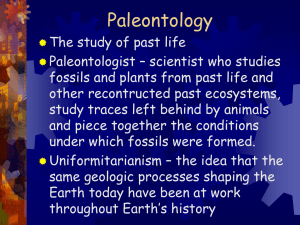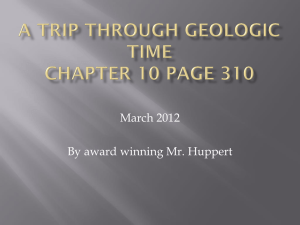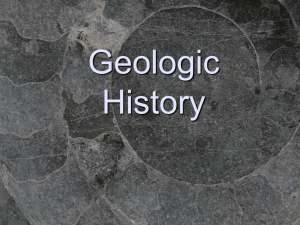Notes For Chapter 3 - Geologic Time
advertisement
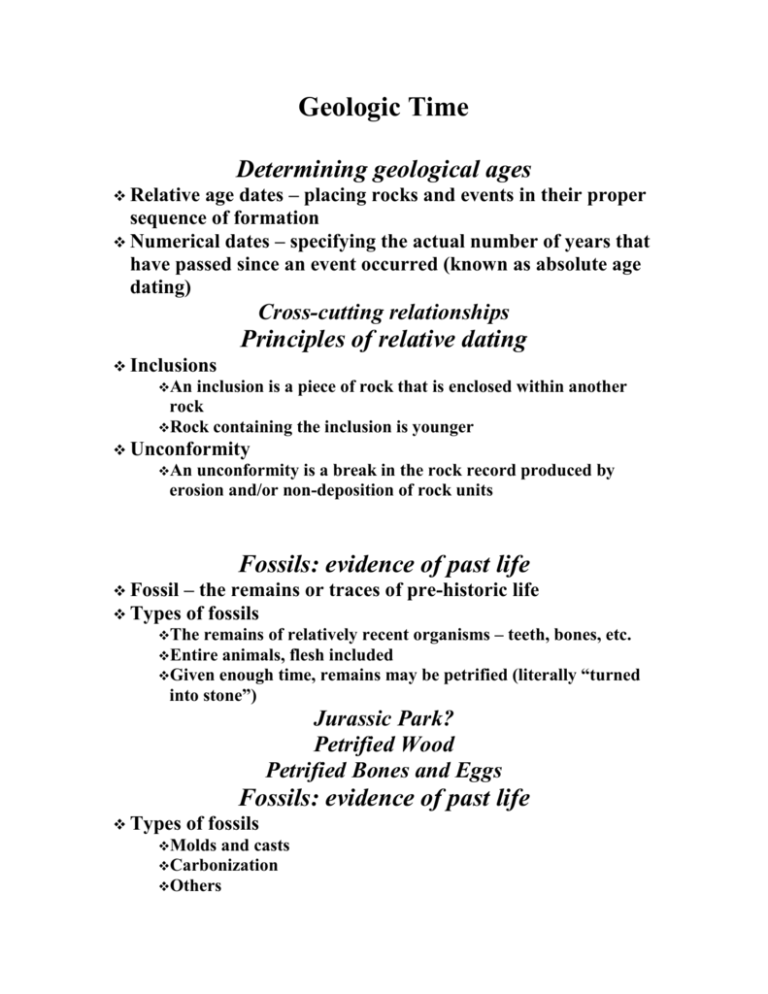
Geologic Time Determining geological ages age dates – placing rocks and events in their proper sequence of formation Numerical dates – specifying the actual number of years that have passed since an event occurred (known as absolute age dating) Relative Cross-cutting relationships Principles of relative dating Inclusions An inclusion is a piece of rock that is enclosed within another rock Rock containing the inclusion is younger Unconformity An unconformity is a break in the rock record produced by erosion and/or non-deposition of rock units Fossils: evidence of past life – the remains or traces of pre-historic life Types of fossils Fossil remains of relatively recent organisms – teeth, bones, etc. Entire animals, flesh included Given enough time, remains may be petrified (literally “turned into stone”) The Jurassic Park? Petrified Wood Petrified Bones and Eggs Fossils: evidence of past life Types of fossils Molds and casts Carbonization Others Tracks Burrows Coprolites (fossil dung) Gastroliths (polished stomach stones) Trace Fossils - Tracks Conditions favoring preservation Rapid burial Possession of hard parts Correlation of rock layers Matching of rocks of similar ages in different regions is known as correlation Correlation often relies upon fossils William Smith (late 1700s-early 1800s) noted that sedimentary strata in widely separated areas could be identified and correlated by their distinctive fossil content Correlation of rock layers Correlation often relies upon fossils of fossil succession – fossil organisms succeed one another in a definite and determinable order, and therefore any time period can be recognized by its fossil content Principle Index fossils Widespread Limited geographically to short span of geologic time Dating rocks using fossils Using radioactivity in dating Reviewing basic atomic structure Nucleus Protons – positively charged particles with mass – neutral particles with mass Neutrons Electrons Reviewing – negatively charged particles that orbit the nucleus basic atomic structure Atomic number An element’s identifying number Equal to the number of protons in the atom’s nucleus Mass number Sum of the number of protons and neutrons in an atom’s nucleus Reviewing basic atomic structure Isotope Variant of the same parent atom in the number of neutrons Results in a different mass number than the parent atom Differs Radioactivity Spontaneous changes (decay) in the structure of atomic nuclei Types of radioactive decay Alpha emission Emission Mass of 2 protons and 2 neutrons (an alpha particle) number is reduced by 4 and the atomic number is lowered by 2 Types of radioactive decay Beta emission An electron (beta particle) is ejected from the nucleus number remains unchanged and the atomic number increases by Mass 1 Types of radioactive decay Electron capture An electron is captured by the nucleus The electron combines with a proton to form a neutron Mass number remains unchanged and the atomic number decreases by 1 Types of radioactive decay – an unstable radioactive isotope Daughter product – the isotopes resulting from the decay of a parent Half-life – the time required for one-half of the radioactive nuclei in a sample to decay Radiometric dating Parent Principle of radioactive dating The percentage of radioactive atoms that decay during one half-life is always the same (50 percent) However, the actual number of atoms that decay continually decreases Comparing the ratio of parent to daughter yields the age of the sample Radiometric Useful dating radioactive isotopes for providing radiometric ages Rubidium-87 Thorium-232 Two isotopes of uranium Potassium-40 Radiometric Sources dating of error A closed system is required To avoid potential problems, only fresh, unweathered rock samples should be used Dating with carbon-14 (radiocarbon dating) Half-life of only 5730 years Used to date very recent events Carbon-14 is produced in the upper atmosphere Useful tool for anthropologists, archeologists, and geologists who study very recent Earth history Importance of radiometric dating Radiometric dating is a complex procedure that requires precise measurement Rocks from several localities have been dated at more than 3 billion years Confirms the idea that geologic time is immense Difficulties Not in dating the geologic time scale all rocks can be dated by radiometric methods Grains comprising detrital sedimentary rocks are not the same age as the rock in which they formed The age of a particular mineral in a metamorphic rock may not necessarily represent the time when the rock formed Difficulties in dating the geologic time scale Datable materials (such as volcanic ash beds and igneous intrusions) are often used to bracket various episodes in Earth history and arrive at ages Dating sedimentary strata radiometrically Geologic time scale The geologic time scale – a “calendar” of Earth history Subdivides geologic history into units Originally created using relative dates Structure Eon of the geologic time scale – the greatest expanse of time Structure of the geologic time scale Names of the eons Phanerozoic (“visible life”) – the most recent eon, began about 540 million years ago Proterozoic Archean Hadean – the oldest eon Precambrian time Nearly 4 billion years prior to the Cambrian period Not divided into smaller time units because the events of Precambrian history are not know in great enough detail First abundant fossil evidence does not appear until the beginning of the Cambrian Key Terms Chapter 3 Relative age Stratigraphy Absolute (numerical age) Unconformity (angular, disconformity, nonconformity) Law of superposition Original horizontality Cross-cutting relationships Paleontology Correlation Geologic column (time scale) Radioactivity Half-life Radiometric dating Paleomagnetism Magnetic reversal
